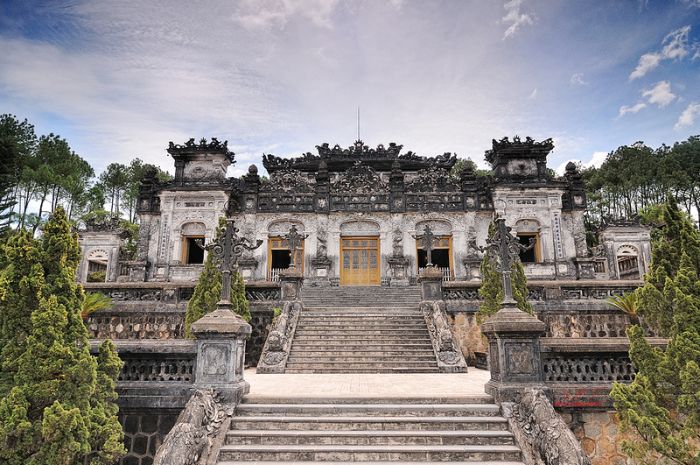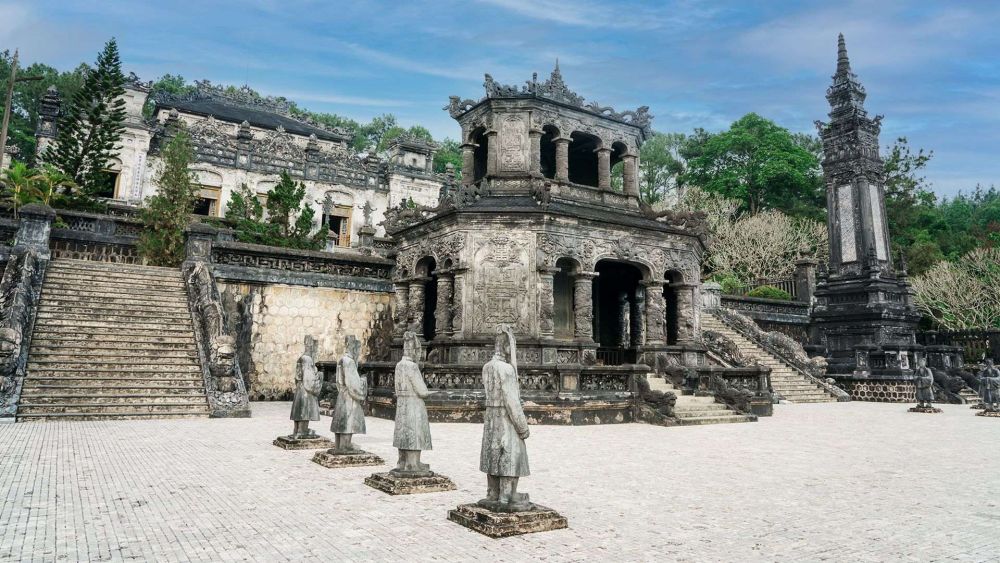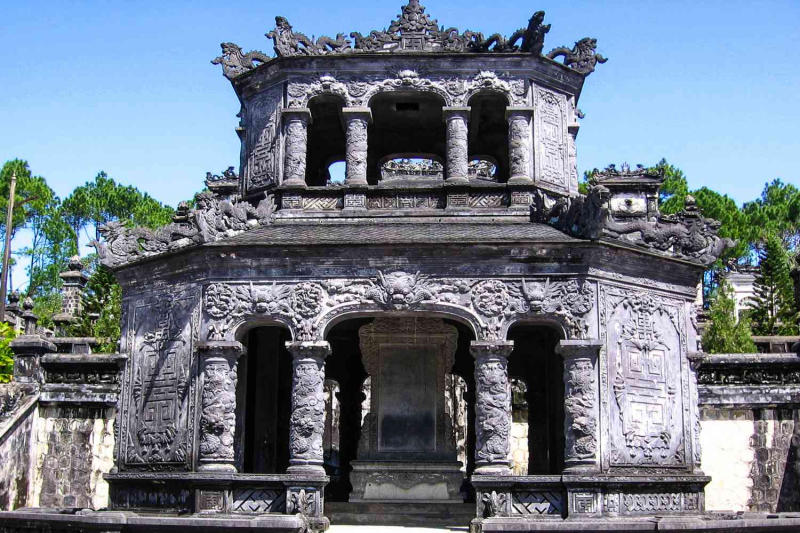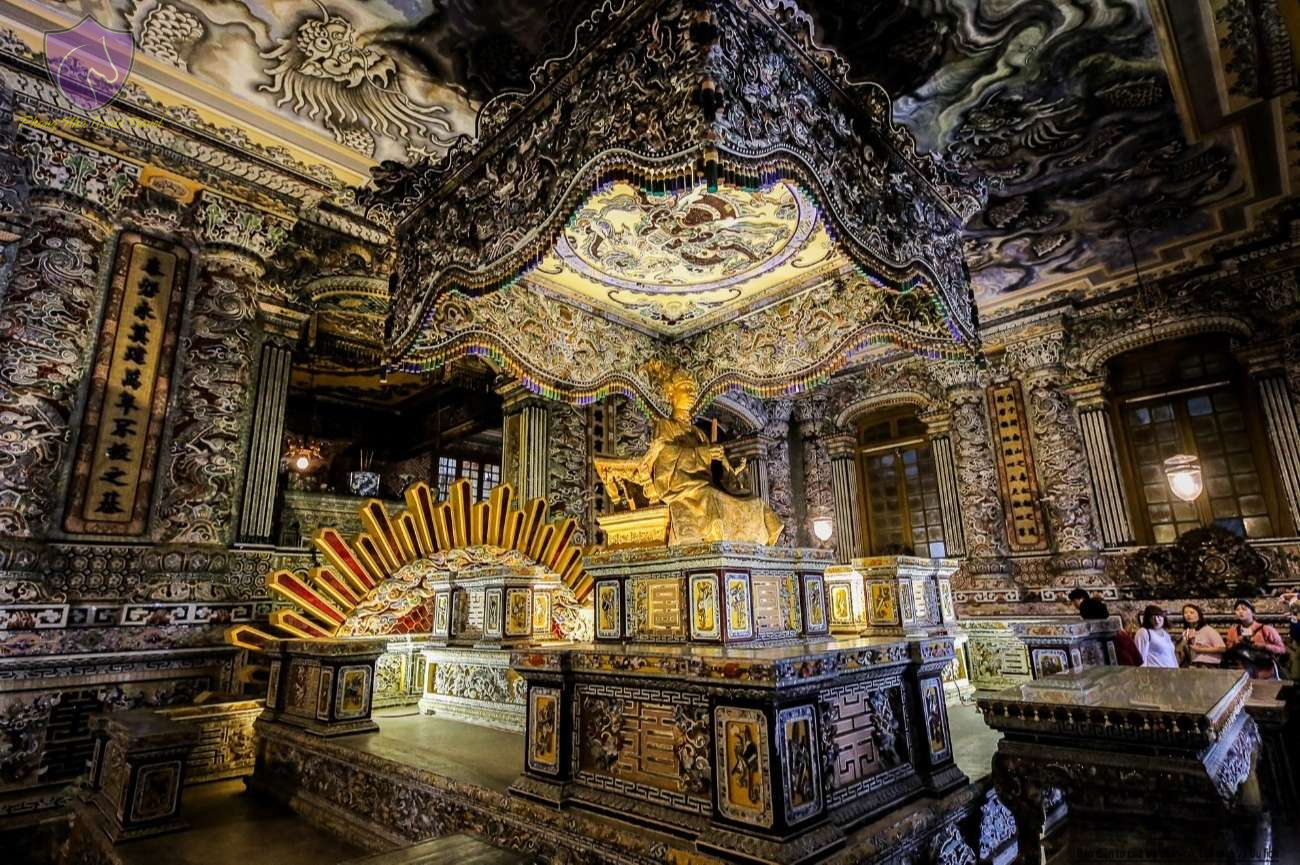Situated in the hills of Hue, Vietnam, Khai Dinh Tomb (Vietnamese: Lăng Khải Định) is not only an architectural marvel but also a unique blend of cultural influences that showcase the tastes and ambitions of Emperor Khai Dinh. Completed in 1931, this iconic structure stands out for its fusion of Vietnamese and European styles, creating a tomb that both honors and challenges traditional designs. From elaborate mosaics to grand statues, Khai Dinh Tomb in Hue offers visitors a chance to step into Vietnam's imperial history and witness the grandeur of the Nguyen Dynasty in a stunning, serene landscape. Whether you're a history enthusiast or an architecture lover, Khai Dinh Tomb is a must-visit landmark in Hue.
Introduction to Khai Dinh Tomb in Hue

Overview of Khai Dinh tomb
Khai Dinh Tomb, the resting place of Vietnam's 12th Nguyen Emperor, stands as a remarkable blend of Vietnamese tradition and Western influences. Located in Hue, a city celebrated for its royal heritage, the tomb is one of the most unique imperial sites in the country. Unlike any other royal tomb, Khai Dinh Tomb reflects the personal tastes of Emperor Khai Dinh, who sought to make his mark with a grand, distinctive structure. This tomb, built over 11 years, is an architectural marvel that intertwines Vietnamese, Chinese, and French styles, making it a must-see attraction for those exploring Hue's rich cultural landscape.
History of Khai Dinh Tomb: The vision of Emperor Khai Dinh

The vision of Emperor Khai Dinh
Emperor Khai Dinh’s unique vision and legacy: Khai Dinh Tomb was commissioned by Emperor Khai Dinh in 1920 and took eleven years to complete. The Emperor’s choice to incorporate both Eastern and Western elements reflects his fascination with European culture, particularly French architecture, which he encountered during his travels. Unlike the other emperors of the Nguyen Dynasty who opted for traditional Vietnamese designs, Khai Dinh aimed to create a tomb that would stand out as both a tribute to his reign and a symbol of his modern ideals.
Controversial architectural choices: The emperor’s decision to use French-imported materials, such as cement and wrought iron, was viewed by many as a departure from tradition, sparking criticism from some Vietnamese nobles and scholars. Despite this, Khai Dinh’s tomb remains a unique structure that symbolizes the blending of two worlds – the ancient and the modern. The tomb’s completion in 1931, just before the end of the Nguyen Dynasty, marked the close of an era in Vietnam's imperial history.
Architectural significance of Khai Dinh Tomb

Hue tomb of Khai Dinh is an architectural marvel
Khai Dinh Tomb is an architectural marvel that reflects the emperor’s fascination with blending traditional Vietnamese and Western styles. Unlike other royal tombs, Khai Dinh’s final resting place includes elements of Gothic and Baroque architecture alongside traditional Vietnamese motifs. The use of blackened concrete, decorative ironwork, and the vibrant mosaics all contribute to its distinctive appearance, making it one of the most unique structures in Vietnam.
The exterior’s dark, weathered appearance contrasts starkly with the brightly colored interiors, which are adorned with elaborate, hand-crafted mosaics of glass and ceramics. Each detail within the tomb tells a story of Vietnam’s evolving identity and the emperor’s desire to leave a lasting, distinctive mark.
Read more: Hue Imperial City: A complete travel guide to exploring Vietnam's cultural heritage
Exploring Khai Dinh Tomb: Must-see highlights
Khai Dinh Tomb is a unique marvel among Vietnam’s imperial mausoleums, blending traditional Vietnamese styles with French, Chinese, and Gothic elements. Each section of the tomb is carefully designed, reflecting Emperor Khai Dinh’s desire for a modern, yet timeless resting place that would stand apart from other Nguyen Dynasty tombs. A journey through Khai Dinh Tomb is a journey through history, art, and the unique vision of one of Vietnam's most unconventional emperors. Below are the must-see highlights that make this tomb a fascinating stop on any trip to Hue.
The grand entrance staircase

Visitors are immediately struck by the grandeur of the entrance staircase
Upon arriving at Hue tomb of Khai Dinh, visitors are immediately struck by the grandeur of the entrance staircase. This magnificent staircase is flanked by intricately carved stone dragons, each symbolizing strength and nobility. Crafted from sturdy cement imported from France, the staircase represents a harmonious blend of resilience and artistry. The dragons’ detailed carvings are among the most exquisite found in the Hue imperial tombs, showcasing the exceptional craftsmanship and attention to detail that define Khai Dinh Tomb.
As you ascend the staircase, the imposing presence of the dragons sets the tone for the awe-inspiring journey ahead. The staircase leads to a series of terraces and platforms, each designed to guide visitors deeper into the tomb's complex layout. The meticulous design ensures a seamless flow from one section to the next, allowing visitors to fully immerse themselves in the historical and cultural significance of the site.
Stele pavilion: The emperor’s story in stone

The Stele Pavilion stands as a cornerstone of Khai Dinh Tomb's narrative
Transitioning from the grand entrance, the Stele Pavilion stands as a cornerstone of Khai Dinh Tomb's narrative. This pavilion houses a large stone stele that intricately recounts the life and accomplishments of Emperor Khai Dinh. Authored by his successor, Emperor Bao Dai, the stele serves as a monumental tribute to Khai Dinh's reign and his contributions to the Nguyen Dynasty.
Crafted from durable granite, the stele is a testament to the enduring legacy of Emperor Khai Dinh. The meticulous calligraphy and elaborate carvings narrate the emperor's journey, highlighting his achievements, aspirations, and the cultural advancements he championed. Each line of text and every decorative element on the stele offers insights into the emperor's vision and the historical context of his rule.
Visitors to the Stele Pavilion can spend time appreciating the intricate details and the craftsmanship involved in creating such a significant artifact. The pavilion not only honors the emperor but also serves as an educational centerpiece, providing a deeper understanding of the historical and cultural landscape of Hue during Khai Dinh's era.
Courtyard of mandarins

Courtyard of Mandarins
Continuing your exploration, the Courtyard of Mandarins is one of the most striking and symbolic areas within Khai Dinh Tomb. This expansive courtyard is adorned with life-sized statues of mandarins, soldiers, and horses, each meticulously crafted to stand as guardians of the emperor’s soul. These statues embody the loyalty, respect, and protection that Emperor Khai Dinh commanded during his lifetime.
The figures in the Courtyard of Mandarins are notable for their exquisite detailing. Each mandarin is depicted with individualized facial expressions and distinct armor, reflecting the skilled craftsmanship of the artisans who created them. The soldiers and horses add a dynamic element to the courtyard, showcasing the military prowess and ceremonial significance of the emperor’s reign.
As you walk through the courtyard, the lifelike presence of these statues evokes a sense of reverence and admiration. The Courtyard of Mandarins not only highlights the artistic excellence of the Nguyen Dynasty but also symbolizes the emperor's enduring legacy and the values he upheld.
Thien Dinh Palace: The heart of Khai Dinh Tomb

Arguably the most ornate and elaborate part of Khai Dinh Tomb is Thien Dinh Palace
Arguably the most ornate and elaborate part of Khai Dinh Tomb is Thien Dinh Palace, where Emperor Khai Dinh’s remains are enshrined. This section of the tomb is a masterpiece of decorative art, featuring intricate mosaic work that covers the walls, ceilings, and columns. The vibrant mosaics depict dragons, floral patterns, and scenes from Vietnamese mythology, creating a dazzling spectacle of color and artistry.
Upon entering Thien Dinh Palace, visitors are immediately immersed in the opulent decor that sets it apart from other imperial tombs in Vietnam. The use of colorful glass mosaics and ceramic tiles highlights the emperor's desire to blend traditional Vietnamese motifs with Western artistic influences. The interplay of light and color within the palace creates a mesmerizing effect, enhancing the spiritual and aesthetic experience.

A bronze statue of Emperor Khai Dinh
At the center of Thien Dinh Palace stands a bronze statue of Emperor Khai Dinh, seated majestically on a gilded throne. This statue, imported from France, captures the emperor’s Western-inspired vision and modern sensibilities, further emphasizing the unique architectural fusion that defines Khai Dinh Tomb. The statue serves as a focal point, symbolizing Khai Dinh’s enduring presence and his aspiration to be remembered as a visionary ruler.
The lavish decorations and intricate artwork within Thien Dinh Palace not only showcase the emperor’s status and wealth but also reflect his commitment to leaving a lasting legacy. Every detail within the palace is thoughtfully designed to honor Khai Dinh’s memory and celebrate the cultural heritage of the Nguyen Dynasty.
Best time to visit the Tomb of emperor Khai Dinh

Best time to visit the Tomb of emperor Khai Dinh
Ideal seasons for exploring Khai Dinh Tomb and Hue
Hue, known for its historical significance and stunning landscapes, has a tropical climate with distinct rainy and dry seasons. Deciding when to visit Khai Dinh Tomb depends on your personal preferences, as each season offers a unique experience:
- Dry season (March to August): This is the best time to visit Hue, as the dry season offers plenty of sunlight and minimal rainfall, ideal for exploring historical sites like Khai Dinh Tomb. From March to May, temperatures remain relatively mild, averaging between 25-30°C (77-86°F), making it a pleasant time to stroll through the tomb’s grounds. However, June to August can bring hotter temperatures, sometimes exceeding 35°C (95°F), so morning visits are recommended.
- Rainy season (September to February): While the rainy season can bring frequent showers, it also brings cooler temperatures, usually ranging between 18-24°C (64-75°F). The mist and rain add a mystical quality to the tomb, especially if you’re interested in photography. The rainy season is generally less crowded, offering a quieter experience, though heavy rain may affect accessibility to certain areas.
When to avoid the crowds
To experience Khai Dinh Tomb with fewer visitors, plan your visit early in the morning or later in the afternoon, especially during peak travel months (April and December). The early hours provide not only peaceful exploration but also softer light, ideal for taking photos of the tomb’s intricate details.
How to reach Khai Dinh Tomb
Transportation options for visiting the Tomb of Khai Dinh
- Motorbike or bicycle rental: For an adventurous experience, visitors can rent a motorbike or bicycle in Hue and reach Khai Dinh Tomb within 30-45 minutes.
- Taxi or private car: Hiring a taxi or car with a driver is the most comfortable way, especially for families or groups. Many drivers offer half- or full-day rates for tomb tours.
- Organized tours: Numerous guided tours from Hue include transportation to Khai Dinh Tomb, along with other nearby attractions. These tours often provide valuable historical insights and allow visitors to see multiple sites without navigating independently.
Helpful tips for exploring the tomb
- Arrive early or late: Early mornings or late afternoons are the best times to visit for cooler temperatures and fewer crowds.
- Dress modestly: As a sacred site, respectful attire is encouraged, including covered shoulders and knees.
- Stay hydrated: The tomb has open, sun-exposed spaces, so bring water to stay hydrated.
Nearby Attractions
While visiting Khai Dinh Tomb, you can explore other historical sites in Hue to deepen your understanding of Vietnam’s imperial history:
Tu Duc Tomb

Tu Duc Tomb
Tu Duc Tomb offers a serene atmosphere with its poetic layout and peaceful landscapes of lotus ponds and shaded pavilions. Built by Emperor Tu Duc as a sanctuary, it provides a tranquil contrast to the grandeur of Khai Dinh Tomb and invites visitors to enjoy quiet reflection amidst nature.
Read more: Tomb Tu Duc: An enchanting sanctuary of the Nguyen Dynasty
Minh Mang Tomb
Known for its classical Vietnamese design, Minh Mang Tomb is set amid scenic lakes and lush forests. The tomb’s symmetrical layout and natural surroundings make it an ideal spot for relaxation, showcasing the harmony between architecture and nature, as envisioned by Emperor Minh Mang.
Hue Imperial City (Citadel)

Hue Imperial City (Citadel)
Located in central Hue, the Citadel was the political and cultural heart of the Nguyen Dynasty. This UNESCO World Heritage site is a vast complex of palaces, temples, and gardens, including the exclusive Forbidden Purple City. A visit to the Citadel offers a fascinating look into the legacy of Vietnam’s imperial history and the architectural grandeur of the Nguyen emperors.
Planning a visit to Khai Dinh Tomb is easier with a travel agency that understands the local culture and history. Sinhcafe provides tailored tours that cover all major tombs in Hue, including insights into their significance. Their experienced guides and customizable itineraries ensure a memorable journey through Vietnam’s imperial history, offering a unique perspective on the Nguyen Dynasty and its lasting impact.